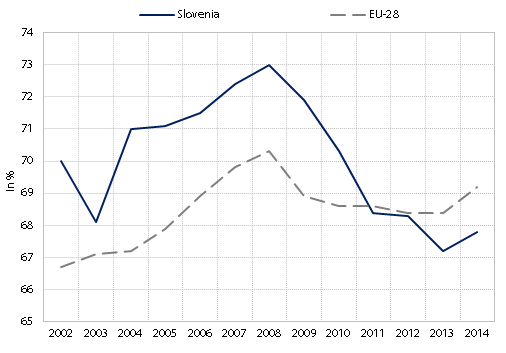MATERIAL WELL-BEING - Work and employment
The indicator Employment rate for the population aged 20-64 years presents the share of population in the mentioned age group who were in employment compared to the total population in the same age group. Because work is the main source of income for most individuals, this is a good indicator of the general material well-being of the population. Growth of the employment rate has a positive impact on well-being.
Figure: Employment rate for the population aged 20-64 years, Slovenia and the EU, 2002–2014 (in %)

Source of data: Eurostat.
The employment rate for the population aged 20-64 years further declined in 2013; with economic recovery in 2014 it increased by 0.6 percentage points to 67.8%, which is 5.2 percentage points less than in 2008. Whereas before the crisis it was gradually increasing and was higher than the EU average, with the drop in economic activity in 2009 it declined, gradually below the EU average. With economic recovery and improvement of the labour market situation, last year it slightly increased, but it was still much lower than in 2008. Despite the increase, in 2014 it was still 1.4 percentage points behind the EU average, mostly as a result of a larger drop in economic activity in Slovenia than in the EU.
Results of supplementary indicators show:
In 2013, the employment rate of young persons (age group 20-24 years) was 39.7%. In 2014, it remained at a similar level. Since 2008, when it was the highest, it dropped by as much as 15.9 percentage points. It fell below the EU average of 48.5% in 2009.
The employment rate of older persons (age group 55-64 years) was 32.9% in 2012, i.e. about the same as in 2008 and slightly lower than a year before the crisis. In 2013 and 2014 it grew to 35.4%, but it was still much lower than in the EU overall (51.8%).
In 2013, the average number of hours actually worked per week in Slovenia grew modestly to 38.6, while in 2014 it again slightly decreased to 38.4; this is less than in 2008 (39.5), but still above the EU average (36.5).
The share of persons in temporary employment (age group 15-64 years) increased in the 2000–2011 period and in 2011 reached the highest value (18.0%), which was above the EU average (14.0%). In the next two years it was gradually falling to 16.3% in 2013. In 2014, it was at a similar level, which is more than in the EU overall (14.0%).
The at-risk-of-poverty rate of persons in employment was gradually falling until 2009. A larger increase happened in the 2011–2013 period. In 2013, it stood at 7.1%, i.e. 2.0 percentage points over the 2008 value, but still below the EU average (8.9%).
During the crisis, the unemployment rate (age group 15-74 years) jumped to 10.1% in 2013. With economic recovery in 2014, the rate slightly decreased (to 9.7%) and was lower than the EU average (10.2%).
The long-term unemployment rate in Slovenia was 5.2% in 2013; in 2014 it was 0.1 percentage points higher. The rate has been rapidly growing since 2009, when it was 1.8% and much lower than the EU average (3.0%). By 2014 (5.3%) it has grown above the EU average (5.1%).
